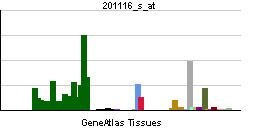Entrez 1363 | Ensembl ENSG00000109472 | |
 | ||
Aliases CPE, CPH, carboxypeptidase E External IDs OMIM: 114855 MGI: 101932 HomoloGene: 48052 GeneCards: CPE | ||
Carboxypeptidase E (CPE), also known as carboxypeptidase H (CPH) and convertase, is an enzyme that in humans is encoded by the CPE gene This enzyme catalyzes the release of C-terminal arginine or lysine residues from polypeptides.
Contents
CPE is involved in the biosynthesis of most neuropeptides and peptide hormones. The production of neuropeptides and peptide hormones typically requires two sets of enzymes that cleave the peptide precursors, which are small proteins. First, proprotein convertases cut the precursor at specific sites to generate intermediates containing C-terminal basic residues (lysine and/or arginine). These intermediates are then cleaved by CPE to remove the basic residues. For some peptides, additional processing steps, such as C-terminal amidation, are subsequently required to generate the bioactive peptide, although for many peptides the action of the proprotein convertases and CPE is sufficient to produce the bioactive peptide.
Tissue distribution
Carboxypeptidase E is found in brain and throughout the neuroendocrine system, including the endocrine pancreas, pituitary, and adrenal gland chromaffin cells. Within cells, carboxypeptidase E is present in the secretory granules along with its peptide substrates and products. Carboxypeptidase E is a glycoprotein that exists in both membrane-associated and soluble forms. The membrane-binding is due to an amphiphilic α-helix within the C-terminal region of the protein.
Species distribution
Carboxypeptidase E is found in all species of vertebrates that have been examined, and is also present in many other organisms that have been studied (nematode, sea slug). Carboxypeptidase E is not found in the fruit fly (Drosophila), and another enzyme (presumably carboxypeptidase D) fills in for carboxypeptidase E in this organism. In humans, CPE is encoded by the CPE gene.
Function
Carboxypeptidase E functions in the production of nearly all neuropeptides and peptide hormones. The enzyme acts as an exopeptidase to activate neuropeptides. It does that by cleaving off basic C-terminal amino acids, producing the active form of the peptide. Products of carboxypeptidase E include insulin, the enkephalins, vasopressin, oxytocin, and most other neuroendocrine peptide hormones and neuropeptides.
It has been proposed that membrane-associated carboxypeptidase E acts as a sorting signal for regulated secretory proteins in the trans-Golgi network of the pituitary and in secretory granules; regulated secretory proteins are mostly hormones and neuropeptides. However, this role for carboxypeptidase E remains controversial, and evidence shows that this enzyme is not necessary for the sorting of regulated secretory proteins.
Clinical significance
Mice with mutant carboxypeptidase E, Cpefat, display endocrine disorders like obesity and infertility. In some strains of mice, the fat mutation also causes hyperproinsulinemia in adult male mice, but this is not found in all strains of mice. The obesity and infertility in the Cpefat mice develop with age; young mice (<8 weeks of age) are fertile and have normal body weight. Peptide processing in Cpefat mice is impaired, with a large accumulation of peptides with C-terminal lysine and/or arginine extensions. Levels of the mature forms of peptides are generally reduced in these mice, but not completely eliminated. It is thought that a related enzyme (carboxypeptidase D) also contributes to neuropeptide processing and gives rise to the mature peptides in the Cpefat mice.
In obesity, high levels of circulating free fatty acids have been reported to cause a decrease in the amount of carboxypeptidase E protein in pancreatic beta-cells, leading to beta-cell dysfunction (hyperproinsulinemia) and increased beta-cell apoptosis (via an increase in ER-stress). However, because CPE is not a rate-limiting enzyme for the production of most neuropeptides and peptide hormones, it is not clear how relatively modest decreases in CPE activity can cause physiological effects.
